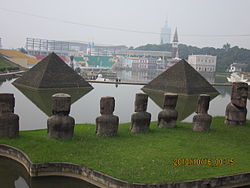| Window of the World | |||||||
|---|---|---|---|---|---|---|---|
| 世界之窗 | |||||||
 Window of the World | |||||||
| Type | Theme park | ||||||
| Location | Xingsha, Changsha County, Hunan | ||||||
| Coordinates | 28°14′20″N113°03′17″E / 28.238899°N 113.054849°E | ||||||
| Area | 0.4-square-kilometre (0.15 sq mi) | ||||||
| Created | October 16, 1997 | ||||||
| Owned by | Hunan TV& Broadcast Intermediary CO., LTD. Overseas Chinese Town Enterprises China Travel Service | ||||||
| Status | Open all year | ||||||
| Website | www | ||||||
| Chinese name | |||||||
| Simplified Chinese | 长沙世界之窗 | ||||||
| Traditional Chinese | 長沙世界之窗 | ||||||
| |||||||
The Window of the World is a theme park located in Changsha, Hunan, China. It has about 50 reproductions of some of the most famous tourist attractions in the world squeezed into 40 hectares. [1]














